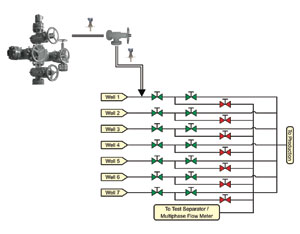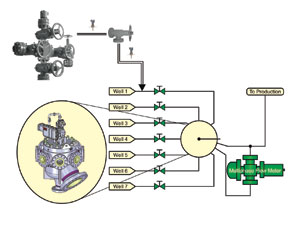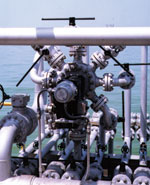
Using multiport flow selectors (MPFS) in oil and gas applications improves production testing and reservoir management.
Introduction
Using multiport flow selectors (MPFS) in oil and gas applications improves production testing and reservoir management. MPFS facilitate cost-effective and compact selection and diversion of fluids from individual wells for testing, without disrupting the production from all other wells. Testing of constituent flows is a crucial part of the production process. Oil, water, brine, condensate, gas, and other fluids must be monitored and measured regularly. Historically, wells were connected to a complex piping network. One manifold connects all wells to production. A second manifold connects the well selected for testing to a shared multi-phase flowmeter or separator plus single phase flowmeter set. While this conventional approach uses common valves, actuators, and piping components – it is more expensive and electrically complex than a multiport system.
Conventional approach
Figure 1 illustrates a typical well test manifold. During normal operation, all the wells are connected to the common production and test lines. For instance, if Well 1 needs to be tested, close valve B and open valve C. The flow of Well 1 is then directed to the test facility while all other wells would continue to the production line.

Regardless of the test technology, individual well flow must be diverted for testing. Typical onshore oil and gas production has wells scattered over a large area, such that it is not practical to manually open and close the manifold on/off valves. The oil field may be in remote deserts, deep jungles, or in sub-zero environments such that local 24x7 human intervention means additional infrastructure. Any scattered network of wells requires high investment during the green field stage of the project (CAPEX) and more maintenance (OPEX) during the operation stage. The initial CAPEX and future OPEX has a positive correlation with the spread and accessibility of the field. Consequently, the flow diversion is usually automated.
In offshore fields, it is important for platform equipment to be as light and small as practical so that the platform is less costly to construct, operate, and maintain. Developers are continually looking for technologies that make offshore platforms more economical. Compared with onshore fields, manual operations on remote platforms are more expensive.
Using a multiport flow selector
A comparison of Figures 1 and 2 shows how the complex network of piping can be minimised by using a MPFS. As illustrated in Figure 2, many elements like valves, control points and wiring of the conventional system can be reduced/eliminated by implementing the MPFS system. MPFS directs multiple wells to a single production flow stream and one well into the test system at the same time.

A Multiport Flow Selector typically has eight inlet and two outlet connections.
• Inlets – seven inlets connect to seven wells, while often the eighth connection is used as a parking location for the selector plug. This allows for an observation port for temporary maintenance and allows production of all seven wells if the test system is offline. The internal plug diverts one well’s fluid stream to the test port at a time. The plug is rotated to align with the well inlet to be tested.
• Outlets – MPFS test outlet connects to the test system and the group outlet carries the flow of all other wells together to the production header.
Normally the pressure drop across a MPFS is very small, as the flow streams are only diverted, not restricted. In some applications, flow velocity will limit the maximum flow or maximum number of connected wells, but this condition is not different from using the conventional dual manifold system.
Operation
An electronic actuator enables easy control and monitoring of a MPFS. Whenever well testing is to be performed, operators simply issue a remote command to position the diverter plug to the desired inlet well. This reduces the chances of manual error in the field which may lead to production downtime and untoward incidents.

Operation can be done remotely and locally as an MPFS actuator supports numerous communication protocols. The actuator’s display shows which well is under test at any given time. Built-in diagnostics also make sure that issues like control error, motor overload, and power loss are resolved immediately.
MPFS provides an additional advantage in sour oil and gas fields. When high nickel-chromium internal cladding is required, the simplified piping and fewer valves results in much lower cladding cost.
</b>Conclusion</b>
In a nutshell, MPFS system compares favourably with a conventional manifold system as detailed in the table.
Well test systems that use MPFS have significant advantages in construction and operations compared with traditional conventional manifold systems. A single MPFS commonly replaces 14 valves and actuators and significantly reduces piping and wiring. These benefits are larger in offshore and sour field production.
With MPFS, well flow is inherently not interrupted when switching lines for testing. Automation is simplified with a single MPFS actuator. Operations and maintenance work hours are reduced, along with the risks related to health, safety, and environmental standards.
For more information contact Michael Eksteen, Emerson Process Management, +27 (0)11 451 3700, michael.eksteen@emerson.com, www.emersonprocess.com
| Tel: | +27 11 451 3700 |
| Fax: | +27 11 451 3800 |
| Email: | emrsouthafrica@emerson.com |
| www: | www.emerson.com |
| Articles: | More information and articles about Emerson Automation Solutions |
© Technews Publishing (Pty) Ltd | All Rights Reserved